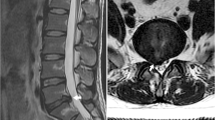Summary
Spinal elastance and the time course of pressure decrease after saline injection into the lumbar subarachnoid space was measured in a control group and in a group of patients with spondylogenic narrowing of the cervical spinal canal. The elastance is higher with retroflexion of the head than with anteflexion. This is more pronounced in degenerative diseases of the spine, proving the existence of a pincers mechanism.
High elastance values at high volume changes indicate a narrowing of the cervical spinal canal. With a normal spinal canal the pressure decrease shows a slow monoexponential slope (T/2=100.8±13.4 seconds).
In patients with partial obstruction of the spinal canal, especially with retroflexion of the head, a secondary pressure increase after termination of the volume injection was observed. This secondary pressure increase decreases in a biexponential manner with a fast slope (T/2=37.62±15.88 seconds) followed by a slow slope. With severe obstructions a plateau remained.
This easily performed and well-tolerated measurement can be of aid in the quantification of obstructions of the spinal subarachnoid space.
Similar content being viewed by others
References
Adams, C. B. T., Logue, V., Studies in cervical spondylotic myelopathy. Brain94 (1971), 557–594.
Braig, A., Biomechanics of the central nervous system. Stockholm: Almqvist and Wiksell. 1960.
Clarke, E., Robinson, P. K., Cervical myelopathy: A complication of cervical spondylosis. Brain79 (1956), 483–510.
Epstein, I. A., Davidoff, L. M., Chronic hypertrophic spondylosis of the cervical spine with compression of the spinal cord and nerve roots. Surg. Gynec. Obstet.93 (1951), 27–38.
Gilland, O., CSF dynamic diagnosis of spinal block: II. The spinal CSF pressure-volume curve. Acta neurol. scand.41 (1965), 487–496.
Gonzales-Feria, L., Peraita-Peraita, P., Cervical spondylotic myelopathy: A cooperative study. Clin. Neurol. Neurosurg.78 (1975), 19–33.
Kaplan, L., Kennedy, F., Effect of head posture on manometrics of cerebrospinal fluid in cervical lesions: New diagnostic test. Brain73 (1950), 337–345.
Kuhlendahl, H., Pathogenese der sogenannten zervikalen Myelopathie, biomechanische und vasozirkulatorische Faktoren. Münch. med. Wschr.111 (1969), 1137–1140.
Löfgren, J., Zwetnow, N. N., Cranial and spinal components of the cerebrospinal fluid pressure-volume curve. Acta Neurol. scand.a 49 (1973), 575–585.
Taylor, A. R., Blackwood, W., Paraplegia in cervical injuries with normal radiographic appearance. J. Bone Jt Surg.30-B (1948), 245–248.
Author information
Authors and Affiliations
Rights and permissions
About this article
Cite this article
Herrmann, H.D., Jaksche, H. Spinal elastance measurement in patients with spondylogenic narrowing of the spinal canal. Acta neurochir 52, 281–288 (1980). https://doi.org/10.1007/BF01402083
Issue Date:
DOI: https://doi.org/10.1007/BF01402083




